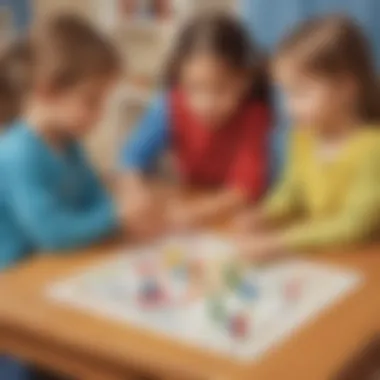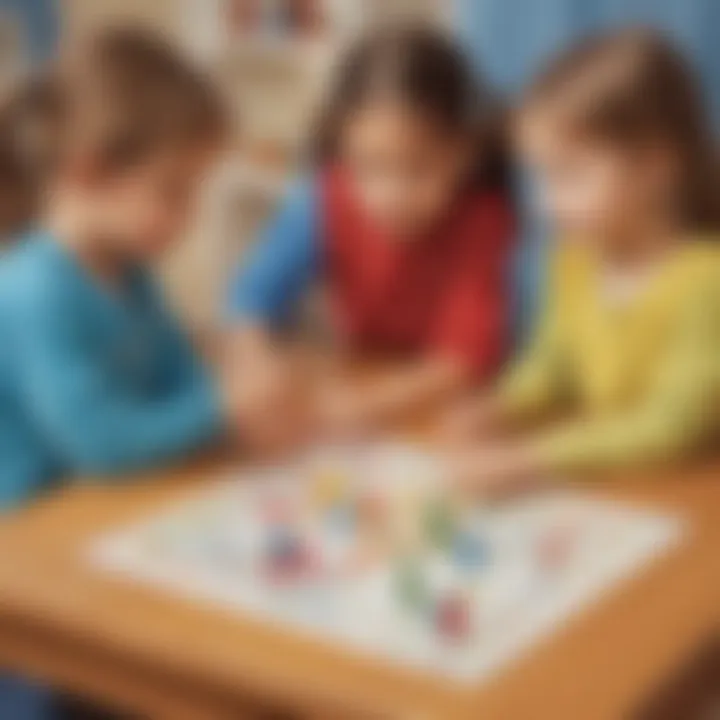Understanding Coordinates for Young Learners


Intro
Understanding coordinates is essential for young learners. Coordinates help us locate points in space, drawing a clear connection between mathematics and the real world. This guide introduces elementary school children to the concept of coordinates in a fun and relatable way. Through simple explanations and engaging activities, children will learn how coordinates work and their importance in daily life. The ideas presented here will make learning about coordinates an exciting journey.
Creative Activities
Craft Ideas
Engaging young minds through creative activities can make learning about coordinates enjoyable. Here are a few craft ideas that incorporate the concept of coordinates in a fun way:
- Coordinate Grid Wall Art: Use colored paper and markers to create a large coordinate grid. Children can plot points with stickers or drawings.
- Treasure Map: Kids can design a treasure map using coordinates to guide their friends to hidden treasures. They will write down the coordinates of each clue.
Step-by-Step Guides
Each activity has its own set of simple instructions to follow. For example, in the coordinate grid wall art:
- Draw a large square on paper and divide it into smaller squares, forming a grid.
- Label the vertical and horizontal axes with numbers.
- Let children choose their favorite colors and plot points.
- Use stickers or drawings to mark each plotted point.
- Discuss the coordinates of each point.
Educational Value
Creating projects allows children to visualize and appreciate the significance of coordinates. It can turn abstract concepts into tangible experiences, improving understanding and retention of the material.
Fun Quizzes
Learning can be reinforced through quizzes. Here are some aspects of the quizzes children can expect:
Quiz Topics
The quizzes cover various topics, such as:
- Introduction to coordinates
- How to read coordinates
- Real-life applications of coordinates
Question Types
Quizzes include multiple-choice questions, fill-in-the-blank, and matching types. These varied formats help keep children engaged and allow them to demonstrate understanding in different ways.
Knowledge Reinforcement
Quizzes enable children to test their knowledge and reinforce their learning. Regular practice helps solidify concepts and boosts confidence in their understanding of coordinates.
Fact-Based Articles
Fact-based articles present a wealth of information in a simplified manner. Topics can range widely, aligned with the interests and levels of comprehension of young learners.
Topics
The articles can cover subjects such as:
- The history of coordinates
- Different types of coordinate systems
- Practical uses of coordinates in everyday life, like mapping and navigation
Engaging Content
Content is designed to be engaging, utilizing visuals and simple language. It helps children grasp the ideas without feeling overwhelmed by complexity.
Intro to Coordinates
Coordinates are fundamental in helping us understand where things are in space. In this guide, we will explore what coordinates are and why they are important. This introduction sets the stage for deeper understanding in our journey around coordinates.


Learning about coordinates is not just an academic exercise. It provides valuable skills. For young learners, grasping these concepts encourages problem-solving abilities and spatial recognition. They become equipped to navigate a world filled with maps, technology, and different forms of media.
This introduction will give a solid foundation. It prepares readers to engage with more complex ideas about types of coordinates, how they are used in everyday life, and their significance in a multitude of fields.
What Are Coordinates?
Coordinates are special numbers that give precise locations in space. Imagine a graph where we can plot points. Each point has a unique location based on a pair of numbers. These numbers are called coordinates. Typically, these include an X value and a Y value.
- The X value shows horizontal position.
- The Y value shows vertical position.
This two-number system helps us know exactly where a point is. For instance, if you think of an empty piece of paper, adding coordinates helps turn it into a map with specific spots. Each coordinate corresponds to a unique point on the graph.
Why Do We Use Coordinates?
We use coordinates for various reasons, making them essential in many activities:
- Navigation: Coordinates help in finding directions. From simple maps to complex GPS systems, they guide us.
- Graphing: In math, coordinates allow us to visualize equations, helping students see patterns and relationships.
- Planning: In fields like architecture and urban planning, coordinates help design layouts of buildings and parks.
In summary, coordinates serve a crucial role in daily life. Understanding them opens doors to numerous fields, including science, technology, and art. Grasping these concepts will enable young learners to navigate effectively and understand their environment better.
Types of Coordinates
Understanding the types of coordinates is essential in grasping how we represent locations in various systems. Each type serves a distinct purpose and is useful in different scenarios. Learning about these types helps young learners see the real-world applications of coordinates, making this fundamental concept more relevant and engaging.
Cartesian Coordinates
The Cartesian coordinate system is perhaps the most well-known type. It is based on two perpendicular lines, called axes. One axis is horizontal (the x-axis), and the other is vertical (the y-axis). Each point in this system is described by two numbers, which indicate its position relative to the axes. The first number tells how far to move along the x-axis, and the second number tells how far to move up or down along the y-axis.
For example, the coordinates (3, 2) mean you move 3 units along the x-axis and then 2 units up. This simple way of plotting points helps in various fields, such as mathematics, engineering, and even art. It promotes logical thinking and problem-solving skills in young learners.
Polar Coordinates
Polar coordinates differ from Cartesian coordinates because they use a circle instead of straight lines. In this system, points are described using a distance from a central point and an angle. The central point is known as the pole, and it can be envisioned as the origin of our circle. The distance from the pole indicates how far away from the center a point is, while the angle shows the direction.
For instance, if a point has polar coordinates of (5, 30°), it means you move 5 units from the center at an angle of 30 degrees. This type of coordinate system is widely used in navigation, physics, and computer graphics, providing ways to deal with circular and rotational motion more naturally.
Geographic Coordinates
Geographic coordinates are crucial for finding locations on Earth. This system uses two main measurements: latitude and longitude. Latitude measures how far north or south a location is from the equator, while longitude measures how far east or west it is from the Prime Meridian.
For example, the coordinates (34° N, 118° W) refer to a point that is 34 degrees north of the equator and 118 degrees west of the Prime Meridian. Geographic coordinates are vital in fields like cartography, environmental science, and global positioning systems (GPS). They help us accurately represent places on maps and are essential for navigation.
Understanding these types of coordinates opens up a world of exploration and practical applications. They not only aid in visualizing data but also enhance spatial awareness, a skill valuable for many careers.
The Coordinate Plane
The coordinate plane serves as a fundamental framework that allows us to visualize and interact with mathematical concepts. It provides a clear and structured means to represent points in space using numbers. This section will cover the significance of the coordinate plane and how it supports young learners in understanding the relationships between different elements within this mathematical system.
In the coordinate plane, we utilize two perpendicular lines called axes. Each axis forms a unique starting point from which we can measure distances, plot points, and analyze relationships. This organization helps learners grasp how coordinates function in real life. The plane not only reinforces basic mathematical principles, but also lays the groundwork for advanced topics.
Understanding Axes
Axes are integral to the coordinate plane; they help define the dimensions in which we work. The horizontal line is known as the x-axis, while the vertical line is known as the y-axis. Together, these axes create four quadrants where points can be located. Understanding axes allows children to navigate the coordinate plane effectively, facilitating better comprehension of mathematical concepts.
In learning about axes, students can explore how moving left or right along the x-axis changes the value of the first coordinate. Similarly, moving up or down along the y-axis affects the second coordinate. This simple mechanic emphasizes the importance of position and direction.
Plotting Points
Plotting points is an essential process in working with the coordinate plane. It involves marking specific locations based on their coordinate pairs (x, y). The ability to plot points accurately enables learners to visualize relationships between different values.


Creating Coordinates
Creating coordinates involves selecting a point in the coordinate plane based on its x and y values. The coordinates are written as an ordered pair with the x-value first, followed by the y-value. This process is fundamental in understanding how different values correspond to specific locations in the plane.
A key characteristic of creating coordinates is simplicity. This clarity makes it a popular choice for introducing students to mathematical concepts. The unique feature of creating coordinates lies in the fact that each point corresponds to only one specific pair. However, students should be mindful that not all points are visible at once, especially in larger ranges.
Reading Coordinates
Reading coordinates is the process of interpreting the significance behind an ordered pair. Students learn how to decipher what each number represents on the coordinate plane. The first number indicates movement along the x-axis, while the second number denotes movement along the y-axis.
The value of reading coordinates extends beyond simple interpretation, as it applies critical thinking toward spatial reasoning and numerical relationships. A unique advantage is the comprehension of movement and direction, as students become skilled in navigating the coordinate plane. However, this can also pose challenges, as learners may occasionally confuse the order or value of a pair.
"By understanding both creating and reading coordinates, students gain a deeper insight into the examples and applications of the coordinate system in everyday life."
Thus, mastering the coordinate plane serves as a stepping stone into broader mathematical concepts and real-world applications.
Applications of Coordinates
Understanding how coordinates work is not only vital for learning math but also has many real-life applications. Here, we will explore several aspects that highlight the significance of coordinates. They play a crucial role in navigation, computer graphics, and video games. Each of these areas uses coordinates in unique ways, showcasing their importance in our daily lives. Moreover, learning about these applications helps young learners see that math is not just numbers on a page but has practical usage all around them.
Coordinates in Navigation
Navigation is one of the most significant uses of coordinates. It helps people find their way from one place to another. Many students may have seen or used maps before. When you look at a map, you often see a grid system. This grid is similar to the coordinate plane, where each point is identified by two numbers. These numbers tell you how far to go along the north-south line and the east-west line. This is essential for finding specific locations, whether in a city or on a hiking trail.
Additionally, technology plays a big role in navigation today. GPS, or Global Positioning System, uses a network of satellites. These satellites provide coordinates that tell us exactly where we are on the Earth. This system helps us drive, walk, or cycle to our destinations safely. Understanding how coordinates work makes it easier to appreciate this technology and its usefulness in everyday life.
Coordinates in Computer Graphics
In the world of computer graphics, coordinates are just as important. When artists create images or animations on a computer, they use a coordinate system to place objects in the right place. The screen can be thought of as a large grid, where each point corresponds to a specific coordinate. This allows designers to decide where to put characters, items, and backgrounds.
For example, a video game character must be positioned correctly on the screen to interact with other objects. If coordinates are not used properly, a character might appear off-screen or overlap with another object unintentionally. By learning about coordinates, young learners can understand how animations and graphics work in the games and applications they enjoy.
Coordinates in Video Games
Video games provide a fun and interactive way to learn about coordinates. In these games, players often navigate through maps or levels that are designed using coordinates. Each area of a game world is mapped out with a coordinate system that helps determine where the player can move and what actions they can take.
For instance, in a platform game, players jump from one block to another. Developers set coordinates for each block, allowing the game character to know where they can land. Moreover, games often have checkpoints, which are also defined using coordinates. This positioning helps the game run smoothly.
As kids play video games, they can learn that math skills come into play behind the scenes. Recognizing the role of coordinates in games can spark an interest in learning more about math.
"Coordinates provide a framework that helps connect different concepts in the real world."
Overall, understanding the applications of coordinates enhances students’ appreciation for math and its impact on various fields. It connects the dots between abstract concepts and real-world usage thus fostering a more engaging learning experience.
Real-World Examples of Coordinates
Coordinates are not just a concept used in classrooms; they play a vital role in everyday life. Understanding how coordinates function in our world helps us appreciate their practical applications. Children can relate to coordinates when considering where they are going, how to find their friends, or even when playing games. By learning about real-world examples of coordinates, young learners can see their relevance in various situations.
Using Maps
Maps are one of the most common tools that utilize coordinates. When you look at a map, you can see a grid marked with lines. These lines represent latitude and longitude, which are types of geographic coordinates. Henrietta, for instance, might use her map to find out where the nearest playground is. If she sees a dot marking the location, she can find it by identifying its coordinates.
Here are some important points about using coordinates on maps:
- Latitude and Longitude: Latitude tells how far a place is from the equator, and longitude tells how far a place is from the Prime Meridian. Together, they give precise locations.
- Finding Locations: Kids can practice taking coordinates, like "45° N, 75° W," and then find those points on maps.
- Navigation Help: Coordinates allow us to navigate accurately, helping people travel to their desired destinations without getting lost.
"Understanding how coordinates work on maps can transform unfamiliar places into recognizable locations for anyone."
Geographic Information Systems (GIS)


Geographic Information Systems, or GIS, is another important application of coordinates. GIS technology helps in collecting, storing, and analyzing data related to Earth’s surface. It allows people to visualize and understand information in a geographical context. For example, supermarkets might use GIS to find the best locations for new stores by analyzing where people live and shop.
Here are some key aspects of GIS:
- Data Analysis: GIS uses coordinates to analyze information about different places, helping businesses and governments make informed decisions.
- Map Creation: By using coordinates, GIS can create maps that show a variety of data, like population density or climate changes.
- Community Planning: Town planners use GIS to understand where roads, parks, and schools should go, ensuring they meet community needs.
Understanding these real-world examples enables young learners to appreciate the essential function of coordinates. It connects their knowledge to how the world operates, urging them to explore more, whether in their own neighborhoods or through technology.
Interactive Learning with Coordinates
Learning about coordinates can be more than just numbers and lines on paper. Interactive learning allows kids to engage with these concepts actively. It makes understanding coordinates enjoyable and memorable. This section discusses two ways to help children learn about coordinates through fun activities: games and mapping.
Coordinate Games
Games are a fantastic way to teach coordination skills while having fun. They transform abstract learning into practical experience. Through these games, children can grasp how to use coordinates in real-life situations. Here are some ideas for coordinate games:
- Coordinate Battleship: This game is a twist on the classic Battleship. Kids use grid coordinates to locate their opponents’ ships. They learn to read and understand coordinates while strategizing their moves.
- Treasure Hunt: Create a simple treasure map using coordinates. Give clues in the form of x, y pairs where children must work together to find hidden treasures. This exercise teaches teamwork, critical thinking, and the practical application of coordinates.
By engaging with these games, learners not only have fun but also develop valuable skills. They learn spatial awareness and improve their understanding of how coordinates relate to positions.
Mapping Activities
Mapping activities are another effective way to teach coordinates. They provide hands-on experiences that reinforce learning. Children can work on creating their own maps using coordinates. This makes concepts like location and navigation clear and applicable.
Some mapping activities include:
- Draw Your Neighborhood Map: Have children draw a simple map of their neighborhood. They can mark important places using coordinates. This not only improves their drawing skills but also helps them visualize their surroundings in a new way.
- Create a Coordinate Grid: Children can create a grid on graph paper and plot various points. You can ask them to label points with numbers or letters to teach how coordinates are formulated.
Through these activities, young learners get to practice using coordinates practically. They grasp the importance of understanding how to navigate using these systems.
"Learning through play enhances cognitive skills. Engaging games and mapping activities can create a strong foundation in understanding coordinates for young learners."
Challenges in Understanding Coordinates
Understanding coordinates is essential for young learners but can come with unique challenges. At first glance, the concept might seem simple. However, various factors can inhibit a child's grasp of how coordinates work. Recognizing potential roadblocks is important in developing effective learning strategies.
Common Misconceptions
Misconceptions about coordinates can often arise. Some children may think that coordinates are purely numbers without any context. For instance, they might see the point (3, 4) and wonder what it represents. Others might get confused with the x-axis and y-axis and mix them up or apply arithmetic incorrectly. Also, some may assume that coordinates are only used in math class, while in reality, coordinates serve many purposes in daily life. To address these misconceptions:
- Use Relatable Examples: Connecting coordinates to familiar experiences, like maps or grid games, helps kids better understand.
- Emphasize Context: Explain that coordinates aren't just numbers; they represent places or positions in space.
- Interactive Tools: Use graphing tools or online resources that visually represent coordinates, allowing learners to practice plotting points.
Tips for Mastering Coordinates
Several tips can help children become more confident with coordinates. Practicing regularly and engaging with the material can make a significant difference in their understanding. Here are some strategies:
- Start Simple: Begin with basic concepts, like understanding the plane, and gradually move towards complex ideas. Encourage kids to plot simple points before getting into more complicated coordinates.
- Use Visual Aids: Visual tools, such as charts or coordinate grids, can clarify how coordinates function in relation to each other.
- Play Games: Incorporate educational games focused on coordinates to make learning enjoyable. Games that require plotting or navigating coordinates can increase interest.
- Collaborative Learning: Encourage group activities where learners can work together to solve coordinate-based problems. This promotes understanding through teamwork and discussion.
"Learning about coordinates can be like solving a puzzle, where each piece helps complete the bigger picture."
Using these tips and acknowledging misconceptions will help reduce challenges students face while learning about coordinates. This approach not only aids comprehension but also builds excitement around the subject.
Finale
Understanding coordinates is a foundational skill in both mathematics and various real-world applications. This article has explored several important concepts about coordinates, providing insights that are tailored for young learners. Recognizing coordinates helps children navigate through different areas of learning, from basic math to more complex subjects like geography and computer science.
Recap of Key Points
- Definition of Coordinates: Coordinates are pairs of numbers used to identify positions on a plane or map.
- Types of Coordinates: We discussed Cartesian, Polar, and Geographic coordinates, each serving unique purposes across different fields.
- Coordinate Plane: Understanding the axes and plotting points on a graph is a crucial skill that begins in elementary school.
- Applications: Coordinates are widely used in everyday tasks such as navigation, computer graphics, and video games.
- Real-World Examples: Using maps and Geographic Information Systems (GIS) helps visualize how coordinates work in practice.
- Interactive Learning: Through games and mapping activities, learning coordinates can be engaging and fun.
- Challenges: Some misconceptions exist, but with the right tips and guidance, mastering coordinates is achievable.
Encouragement to Explore Further
The journey does not end here. There are numerous ways to deepen understanding of coordinates. Children can explore fun websites that offer interactive games centered around coordinates. Hands-on activities, like creating a simple map of their neighborhood using coordinates, can solidify their grasp on the topic.
Visit resources such as Wikipedia and Britannica for more detailed topics. Engaging with technology through apps and educational platforms can also provide additional insights into how coordinates influence our daily lives.







